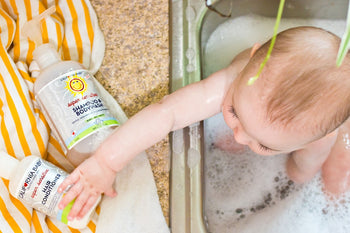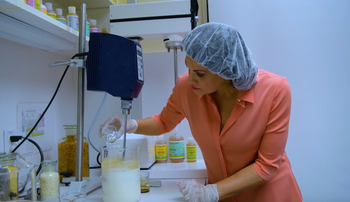It’s normal to want a fast solution to curing diaper rash. Something that will make the problem and the pain just go away right now. The truth of the matter is there's no cure-all for diaper rash and prevention is the name of the game. But when a red, bumpy bum rears its red, bumpy head (and it will) a lot of parents wonder, can I use Vaseline® as a diaper rash cream for baby?

Yes, you can...but
Vaseline is cheap and does work well to create a moisture-sealing barrier, which is exactly what you want in a diaper rash cream for baby. However, the water-repellant film it forms on the applied area doesn’t allow the skin to breathe. So, yes, it creates an effective barrier against the evaporation of skin’s natural moisture, but it also creates an effective pore-blocking barrier that locks in residue and bacteria, both of which can lead to or intensify diaper rash.
The idea that Vaseline® itself is “moisturizing” is also a bit of a misnomer as there simply are no ingredients in it that moisturize or nourish the skin. It’s just a barrier. Bio-based diaper rash creams like our fragrance-free or lavender-scented ointments help create a breathable barrier while also providing soothing and moisturizing benefits with plant-based ingredients like coconut oil, clary sage and tea tree oil.
Vaseline® is petroleum jelly
Vaseline® is a brand name for petroleum jelly or petrolatum. Petrolatum is a byproduct of the petroleum refining process, which literally means it originates at the bottom of oil rigs and is then further refined into use for personal care products. Packaging and safety info might insist that all harmful contaminants are removed from petrochemicals before they end up on your baby’s skin, but outside investigations from organizations such as The Environmental Working Group (EWG) show otherwise. In fact, petrochemicals and their derivative ingredients come with a laundry list of potential human health hazards and proven environmental harm.
 Did you know petroleum jelly is derived from petroleum, a toxic crude oil?
Did you know petroleum jelly is derived from petroleum, a toxic crude oil?
The problems with petroleum jelly and other petrochemicals
When properly refined — meaning when companies do the extensive work to remove all possible contaminants — petrolatum has no known health concerns. However, that’s not always the case and parents have little or no insight into the truth or accuracy of those claims. The refining and testing process can be expensive so many corporations opt out of the extra cost and time it takes to continually test and refine their petroleum-based ingredients to make sure they are contaminant-free. Yet, the problems with petrochemicals in skincare are well documented...
-
Contamination with carcinogenic chemicals
In a 2008 assessment of 15,000 ingredients in personal care products, the EWG found that 22 percent contained 1,4-dioxane, a trace contaminant of petroleum products and a probable human carcinogen as classified by the Environmental Protection Agency (EPA). Not only are they present but they often easily penetrate the skin, contributing to chronic low-level exposure that accumulates over time.
Polycyclic aromatic hydrocarbons (PAHs) are a class of chemicals that also occur naturally in fossil fuels, 14 of which are listed as possible carcinogens and one as a known carcinogen by the International Agency of Research on Cancer (IARC). Thanks to their lipophilic properties, these hydrocarbons are also absorbed into the skin and commonly stored in fat tissue (and breast milk!). In fact, a 2011 study showed strong evidence that hydrocarbons derived from petroleum are likely the most present contaminants in the human body and that cosmetic products, alongside inhalation of polluted air, are a significant source.
-
Depleting a nonrenewable resource
Human health aside, the environmental impacts of the fossil fuel industry are well known and increasingly documented. First and foremost, we know that petrochemicals are not a renewable resource which means even if they were wonderful for our skin (which we’re not convinced they are), the personal care industry can’t rely on them indefinitely. Bio-based solutions aren’t just a healthier but a necessary solution to the depletion of fossil fuels impacting many source countries already.
Fossils fuels — including coal, oil and natural gas — have been supplying economies with energy for decades. But they also come at an energy cost from extraction methods, like mining and drilling, to infrastructure leaks during the refining process that converts crude oil into non-fuel products like plastic, pesticides and the petrochemicals used in personal care products.

-
A major environmental polluter
Local ecosystems and the people who depend on them are also at greater risk of degradation, biodiversity loss and pollution, both of air and water, from the extraction, production and transportation of fossil fuels. Petrochemical plants convert components of oil and gas — like ethane, propane, butane and methane — into chemicals like ethylene, propylene, butadiene and methanol. If leaked into the environment, these chemicals pose significant health risks. Thousands of oil spills occur every year during extraction or transportation, some with catastrophic impacts on habitats.
The pollution problem compounds when you think not only of the petrochemical ingredients in personal care products but also of the single-use virgin plastic — another fossil-fuel derived component — housing those formulas. The personal care industry in the U.S. alone was responsible for 7.9 billion units of new plastic production in 2018, less than 9% of which actually gets recycled. The other 91% ends up in a landfill or water, usually as microplastics making their way up and down every rung of the food chain.

Why we use bio-based ingredients instead of petrochemicals
Biobased ingredients are alternatives to conventional petroleum-derived ingredients and are made from raw materials like plants or other renewable agricultural materials, like lanolin from sheeps’ wool, a common barrier-creating ingredient in diaper rash cream for baby. Our diaper rash ointments use an ultra-purified form of lanolin to remove impurities that can be introduced during the farming process (looking at you, pesticides.)
Biobased products like our diaper rash ointments increase the use of renewable sources while decreasing reliance on unsustainable fossil fuels. They also require less energy and cause less pollution from harvesting through personal use — a big win for communities and ecosystems all over the world. Our 100% bio-based products have been independently lab tested and USDA certified to be free of all petroleum derived chemicals and petrochemical contaminants.

Labels 101:
Petrochemicals take many forms
How do you know if your diaper rash cream for baby contains petrochemicals? They’re not always straightforward on the label. If you come across anything on the list below, you’re dealing with petrochemicals:
- Petrolatum
- Petroleum jelly
- Paraffin oil
- Mineral oil
- White petrolatum (the outlier here, this is fully refined and safe for topical use)
- Toluene
- Benzene
- Any word with propyl — isopropyl alcohol, propylene glycol, propyl alcohol, cocamidopropyl betaine
- Anything with PEG (polyethylene glycol)
- Anything with DEA (diethanolamine) or MEA (ethanolamine)
- Parfum or fragrance — 95 percent of chemicals used in fragrance are petroleum derivatives
In addition to petrochemicals, California Baby formulates without other potentially harmful ingredients, including endocrine disruptors like phthalates and parabens and known allergens, especially synthetic fragrances
The bottom line
Yes, you can use petroleum jelly to create a moisture barrier and help treat diaper rash in a pinch - but you have other (and we’d argue, healthier) options that do everything Vaseline® does without clogging pores or risking contamination with carcinogenic chemicals. When you shop diaper rash ointment and other diaper solutions from California Baby, you know you’re getting the gentlest product possible for your baby’s sensitive skin.

DISCLAIMER: The information contained herein should NOT be used as a substitute for the advice of an appropriately qualified and licensed physician or other health care provider. The information provided here is for informational purposes only.














